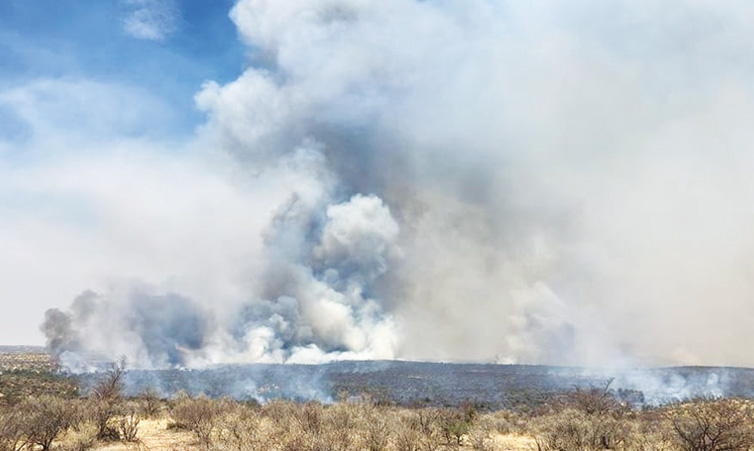By Eliaser Ndeyanale
Copyright namibian

Private firefighters blame the government for failing to heed their proposal to fight the raging Etosha flames, as their request was only approved four days later.
They also accuse the government of lacking emergency planning in its response to the fire that has destroyed thousands of hectares of Etosha National Park.
The fire, which broke out on 22 September near Outjo, spread fast due to strong winds, rendering efforts of the Ministry of Environment and Tourism futile.
Despite the situation getting out of hand, it reportedly took the ministry four days to accept assistance from civilian disaster management organisations and farmers.
The National Emergency Response Unit, headed by Sean Naude, is one of the organisations that was denied.
“If we had acted on day two, pulled together all resources and coordinated with private individuals, this fire could have been contained within three to four days,” Naude says.
He blames the government for lacking the necessary wildfire fighting capacity, such as the Bambi Bucket system used to scoop water from natural sources.
Naude says a few antelopes and countless small species – such as insects, lizards, snakes and pangolins – died because they could not escape the fire.
“Even if it rains tomorrow, it will take ages for the ecosystem to recover,” he says.
The Office of the President on Sunday said the fires pose a threat to the biodiversity, wildlife and livelihoods of the communities in the affected areas.
However, it added that no state of emergency has been declared and a decision will be taken once more information is obtained.
“An unknown number of wildlife has been killed, but thankfully, no human casualties have been reported,” the Presidency said.
Environment ministry spokesperson Ndeshipanda Hamunyela says the Office of the President will release a statement regarding the fire situation.
She denies that the ministry initially declined assistance from private farmers.
“There are so many private farmers in Etosha right now. Who did they approach? We were in Etosha on the third day and there were farmers there. The farmers’ story does not make sense because they have been there for a while now,” she says. According to the environment ministry, about 1.1 million hectares of land has burnt, with about 775 000 hectares, approximately 34%, inside the park.
Authorities say the fire has spread to the north-eastern parts of the park and into the communal areas of the Omusati and Oshana regions, particularly in the constituencies of Uuvudhiya, Otamanzi and Ruacana.
The ministry says the affected routes include the Halali Junction to Rietfontein, the Eland Drive detour and the Rhino Drive detour.
Over 30% of the grazing has been destroyed in the park and the government has intensified its national response to contain the fires, with 40 members of the Namibian Defence Force and an additional 500 dispatched to the area on 27 and 28 September, respectively.
Otamanzi constituency councillor Johannes Iiyambo says livestock herders in the Amarika area of his constituency in the Omusati region are unable to contain the fire.
Speaking to The Namibian yesterday, the councillor said a farmer in the area lost 17 sheep due to the fire. “We are losing the battle. The fire is huge,” Iiyambo said.
He said farmers and villagers tried to extinguish the fire last Monday afternoon but were unsuccessful.
He said the flames were as “high as a double-storey building.”
According to him, where he was, at Eeshipu village, there were no soldiers, only farmers and villagers attempting to contain the blaze.
He added that there were also fires at Onkaankaa, Ushokole and west of Amarika.
Iiyambo urged cattle post owners to clear the dry grass around their posts to prevent houses from catching fire.
“Some cattle posts are surrounded by tall grass, and if the fire reaches them, the houses will burn down,” he said.
Omusati Regional Council chairperson and Ruacana constituency councillor Andreas Shintama says the fire reached his constituency last week but was successfully extinguished.
He adds that villagers from Ruacana are now helping farmers in the Otamanzi and Okahao constituencies to fight the blaze.
“Officials from the Omusati Regional Council, police officers and soldiers are also assisting,” Shintama says.
Onkaankaa headman Muna Shaanika told The Namibian on Sunday that several goats in his village have died – some burned while others died after inhaling excessive smoke.
The government on Saturday announced that it plans to deploy 500 soldiers to fight the fire.
Environment and tourism minister Indileni Daniel says despite these efforts, the situation remains challenging due to strong winds, dry vegetation and limited firefighting equipment.
“I am currently on the ground at Etosha National Park to assess the extent of the fire damage, evaluate the operational needs of deployed teams, provide strategic guidance to ensure an effective and coordinated response, and provide support to the brave men and women working tirelessly to contain the fires,” she says.
She says a postmortem assessment will be conducted once the fires are fully contained to determine the impact on species and habitats.
“We urge all visitors to Etosha National Park to remain vigilant, strictly adhere to park rules and take all necessary precautions. The safety of guests, staff and wildlife is paramount, and cooperation is essential,” she says.



